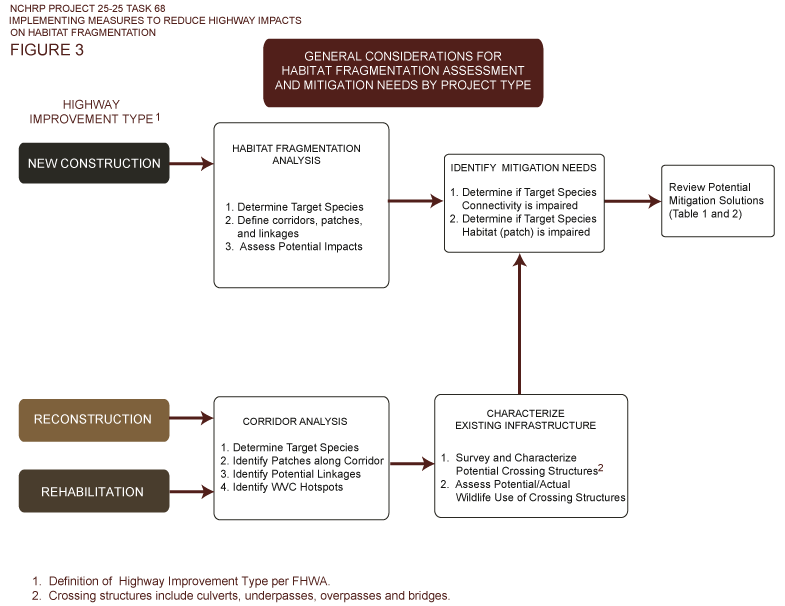III. Decision Support Tool for Habitat Fragmentation Solutions, continued
B. Assessing Habitat Fragmentation and Mitigation Needs Based on Highway Improvement Type
Based on the transportation agency interviews, habitat fragmentation impacts are addressed for different highway improvement types. Figure 3 provides a general framework that outlines key components for assessing habitat fragmentation for different highway improvement types. Highway improvement types addressed in Figure 3 are defined below (FHWA, 1997).
- New Construction - this action involves the construction of a new highway facility where nothing of its type currently exists.
- Reconstruction – this action involves a major change to an existing highway within the same general right-of-way corridor. This may include capacity improvements or may involve making substantial modifications to an older highway's horizontal and vertical alignment in order to eliminate safety and accident problems.
- Resurfacing, Restoration, Rehabilitation (3Rs) – these actions primarily serve the preservation and extension of the service life of existing facilities and on safety enhancements. The types of improvements may include resurfacing, pavement, structural and joint repair, minor lane and shoulder widening, minor alterations to vertical grades and horizontal curves, bridge repair, and removal or protection of roadside obstacles.
New construction projects involve a new roadway alignment that can be more complex and require a larger investment of time to complete a landscape level analysis of habitat fragmentation impacts, often as part of a NEPA study. The process depicted in Figure 3 is simplified to show only the basic steps that should be performed prior to determining the need and type of mitigation required. Similar to reconstruction and rehabilitation projects, the process begins with the analysis of the baseline conditions and the identification of potential impacts for alternatives, prior to the step of identifying mitigation needs for either connectivity or patch impacts. Once the nature of the potential impacts is defined, potential mitigation solutions can be reviewed and evaluated (Tables 3 and 4).
The basic difference between new construction and reconstruction/rehabilitation improvements is that the latter occurs along an established transportation corridor where initial impacts to wildlife habitat and connectivity occurred with the original construction. The process to define habitat fragmentation and identify target species can be much simpler for these projects since the project corridor is established, and the existing structures (culverts, underpasses, overpasses, bridges) and potential wildlife crossings are in place. For instance, if a reconstruction/rehabilitation project involves the replacement of a single culvert or reconstruction of a single bridge, then a landscape level assessment of habitat fragmentation is not necessary. In this case the practitioner may only need to define the target species or wildlife species group, assess types of structures and current use by wildlife, and identify the mitigation need. The practioners can then proceed directly to the list of mitigation solutions for connectivity to begin evaluating mitigation options (Tables 3 and 4). The complexity of the assessment process depends on the project scope, target species and other issues. The level of effort and complexity of analysis may increase depending upon site and project specific conditions.
Unique to reconstruction/rehabilitation projects is the opportunity to survey and characterize the physical features of existing structures and assess their functional potential for wildlife passage (Figure 3 - HTML | Figure 3 - PDF File). Examples of procedures to evaluate existing structures are available. Several states have prepared manuals for the assessment of existing culverts for aquatic wildlife passage. While the manuals focus primarily on fish and not aquatic mammals, the principals for documenting and evaluating existing structures for the passage of aquatic wildlife are applicable. Similar manuals or guidelines for evaluating existing structures for use by terrestrial wildlife have not been identified through the literature review.
Figure 4 is a schematic of a Habitat Fragmentation Assessment within the NEPA Process that provides a conceptual framework for conducting a landscape level habitat fragmentation analysis within the NEPA process. Section C includes a more detailed discussion on the information needs and process to conduct an analysis and define project impacts. A conceptual decision guide is described in the following section that is designed to facilitate the selection of mitigation solutions for connectivity and patch impacts. The information contained in these sections represents a general conceptual approach that can be scaled to apply to any size of highway improvement project. It is not a comprehensive approach and it is not an NCHRP policy statement.
Next: Habitat Fragmentation Assessment within the NEPA Planning Process
